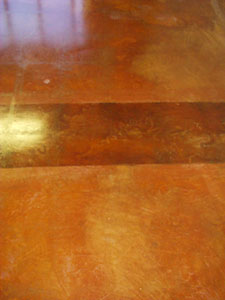 |
|||||||||
| September 02, 2004
In This Issue of The Acid Staining Newsletter Seeing Red
We have often been asked by clients to stain their floor to match an adjoining brick area. It is something I wish we could do, but to date there is no true red in acid stain. Several stain companies publish pretty charts of stain colors which might include one called "Brick" or "English Red." It has been our experience that the red color on these charts is a fabrication. We can make it appear red by adding a strong red tint to our clear topping sealer, but this means that if the floor gets badly scratched the red will disappear along with the sealer. We recently ordered a quart of "English Red" from Kemiko and followed the instructions exactly. The color we obtained was closer to Scofield’s Padre Brown. It was a nice brown without too much orange in it, but by no stretch could it be called "English Red." If your client is determined to have a red floor, he should have the slab poured with lots of integral color in it, or have a topping slab applied which has had red powdered pigment mixed into it generously. Most stain makers also manufacture powders called color hardeners which are meant to be troweled into the surface of a gray slab to alter color and increase durability. Quality Construction makes a Colortech powder called "Bayferrox" or "Salsa Red." www.qcconprod.com This will give the whole slab a flat, uniform, brick red color. This is not a color anyone would want to live with by itself—it has a dull, bland look to it—but it looks gorgeous with a Dark Walnut or Padre Brown stain applied over it. We recently worked on a forty-year old red slab in an office building. It was under VCT tile, so our first chore was to remove lots of black mastic. We hired a young and enthusiastic professional floor cleaner to remove the mastic. He had a high-pressure hot water spray gun which he was very fond of, but that did not do the trick. We recommended several applications of citrus cleaner with subsequent scraping and scrubbing, and left him to do the work. The citrus cleaner took more labor than the impatient young man wanted to spend, so he poured paint thinner all over the floor, let it melt the mastic and then cleaned it off, somewhat. His hot water pressure-washer sent the fumes up a nearby stairwell and into the air ducts; all the upstairs office tenants complained, and some went home early with headaches. Never use paint thinner! We were able to cut the noxious fumes somewhat by mopping the floor three times with water into which we’d added a cup of vanilla. We set up fans, opened doors to the street and let the room ventilate. Three days later, the odor was still discernible. We had to scrub the floor several more times with strong TSP solution to cut the oils in the mineral spirits, prior to staining.
Happy Staining! GG Questions or comments about my newsletter? |
|||||||||
|
|
|||||||||



